Where are the US military bases in the Middle East that could be attacked by Iran?

Iran made good on its threat and retaliated against the United States on Monday for Saturday's bombing of three of its nuclear facilities. This initial action focused on Qatar, which hosts the U.S. military base of Al Udeid, the largest and most important in the Middle East for the nation led by Donald Trump. However, this base is not the only one in the region within range of the Islamic Republic's missiles and the allied militias it has armed in some of the countries where U.S. interests are located.
"Al Udeid Air Base in Qatar has been the target of a powerful and devastating missile attack," the Iranian Armed Forces confirmed in a statement. It added that it is "the United States' most valuable asset in the region."
For its part, Iran's Supreme National Security Council stated that the attack is "a response to the United States' brazen and aggressive act against Iran's nuclear facilities."
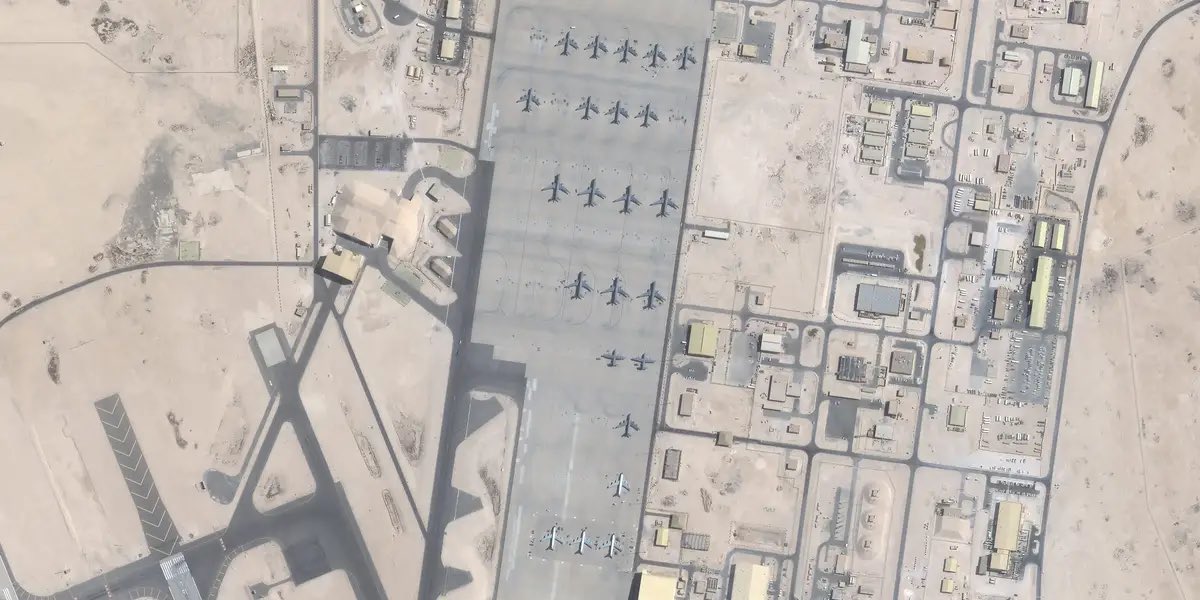
Aerial view of the U.S. military base Al Udeid in Qatar. Photo: Social media
"The number of missiles used in this successful operation was equivalent to the number of bombs the United States used in its attack on Iran's nuclear facilities," he added in a statement.
In its attack on Saturday, the United States dropped a total of 14 GBU-57 bombs weighing more than 13 tons each on the Fordow and Natanz underground facilities. It also fired submarine-launched Tomahawk missiles that hit Isfahan.
For its part, the Pentagon stated that no US casualties were reported in the Iranian attack on its air base.
While Qatar claimed that its air defenses intercepted the Iranian missiles.
In total, the United States has 19 temporary and permanent military installations in 10 Middle Eastern countries, housing approximately 40,000 personnel, both military and civilian.

Attack on US airbase in Qatar Photo: Social media
In addition, the United States has deployed air defense systems, combat aircraft, and warships at these bases.
Of the 19 US bases, eight are permanent and are located in Bahrain, Egypt, Iraq, Jordan, Kuwait, Qatar, Saudi Arabia, and the United Arab Emirates.
With its medium-range missiles, including the Sejjil-2, the most advanced, with a range of up to 2,200 kilometers, Iran could strike virtually any US military base in the Middle East.
Before its attack in Qatar, Iran's Revolutionary Guard had announced what was coming: "The number, dispersion, and size of US military bases in the region are not a strength, but rather have doubled its vulnerability."
In response, Pentagon chief Pete Hegseth warned Iran against attacking its positions in the region : “That would be a very bad idea,” he said on Sunday.
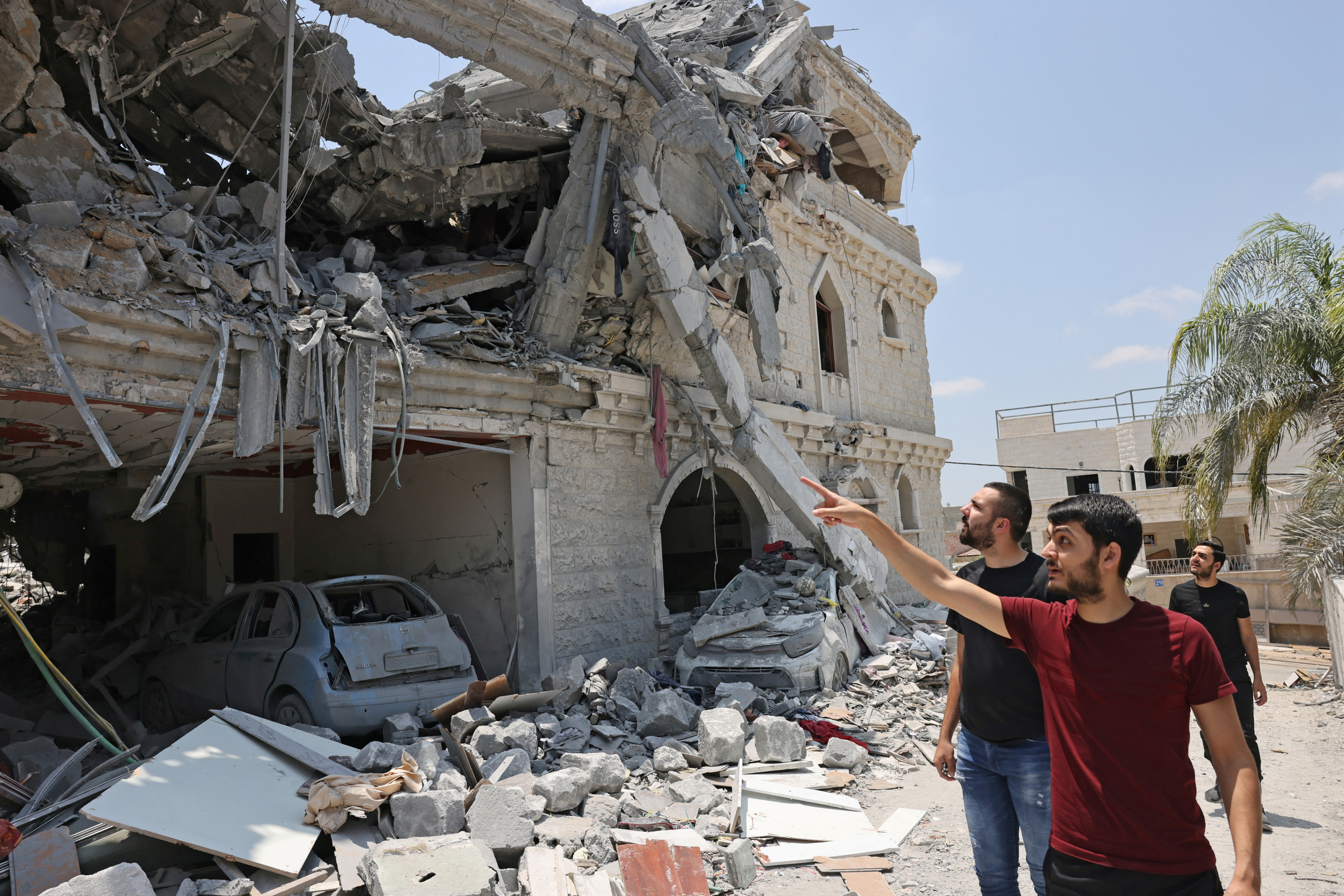
Several men inspect the destruction of a home in the Israeli-Arab town of Tamra. Photo: AFP
Analyst Francisco Belaunde Matossian told El Comercio that Iran had to react in some way to Saturday's attack on its nuclear facilities, but said its retaliation would remain contained, without seeking to escalate the conflict with the United States.
“In some way, the regime's credibility was at stake, so they had to retaliate. But this will remain at the level of the retaliation they carried out in 2020, when the United States, on Donald Trump's orders, killed General Qassem Soleimani in Iraq. It was a planned attack to also signal to the United States that their revenge was over,” Belaunde noted.
Indeed, after Soleimani's death, Iran attacked the US airbase at Ain Al Asad in Iraq with some 12 Qiam-1 missiles, causing head trauma injuries to 110 US soldiers.
"A further escalation with the United States is not in Iran's best interest. Its response capacity is diminished by Israel's attacks, and a strong attack on the United States will generate a much stronger response," Belaunde said.
"Without a doubt, a strong US reaction could ultimately lead to the fall of the ayatollahs' regime. Donald Trump himself has already mentioned that they would seek regime change if Tehran responds violently," he said.
At this point, Belaunde emphasized that if there is a regime change in Iran, a democratic government will not necessarily be installed.

Map of the Al Udeid base in Qatar. Photo: Social media
“Chaos could erupt, a civil war, or the installation of a military dictatorship. That's what the United States caused with Iraq, where it got rid of Saddam Hussein, but in the end it provoked a civil war, the same one that ultimately led to the emergence of the Islamic State, and we all know what that meant,” he said.
The United States military presence in the Middle East Below are the major U.S. bases in the Middle East that are under the supervision of the U.S. military's Central Command (CENTCOM).
Taste It is home to Al Udeid Air Base, the largest U.S. base in the Middle East and its main logistics hub in the region, which also houses the CENTCOM headquarters.
There are approximately 10,000 US troops on site. Operations in Iraq, Syria, and Afghanistan have been coordinated from there.
It has two 3,750-meter runways, suitable for all types of aircraft, from the whirling B-52 strategic bombers to the enormous C-17 military transport aircraft.

#LIVE: Where is #Israel's war against #Iran heading? Photo:
It hosts more than 90 aircraft, including B-52s, KC-135 tankers, C-17s, MQ-9 drones, and reconnaissance aircraft such as the RC-135.
AFP reported that the United States withdrew almost all of its aircraft from the site for fear of Iranian attacks, leaving only three.
Bahrain It is the headquarters of the United States Navy's Fifth Fleet, which is located at the Juffair Naval Base.
The base occupies the site of the former HMS Juffair, installed by the British Navy in 1935. It was transferred to the US in 1971 following Bahrain's independence.
It is responsible for U.S. naval forces in the Persian Gulf, the Red Sea, the Arabian Sea, and the coast of East Africa south to Kenya.
It houses between 8,500 and 9,000 military personnel and civilians spread across some 78 residential units.
Among the vessels at this base are coastal patrol boats, a missile destroyer, ships that detect and neutralize underwater mines, naval helicopters, and others.
Kuwait The United States has numerous bases in Kuwait. The most important is Camp Arifjan, the forward headquarters of CENTCOM.
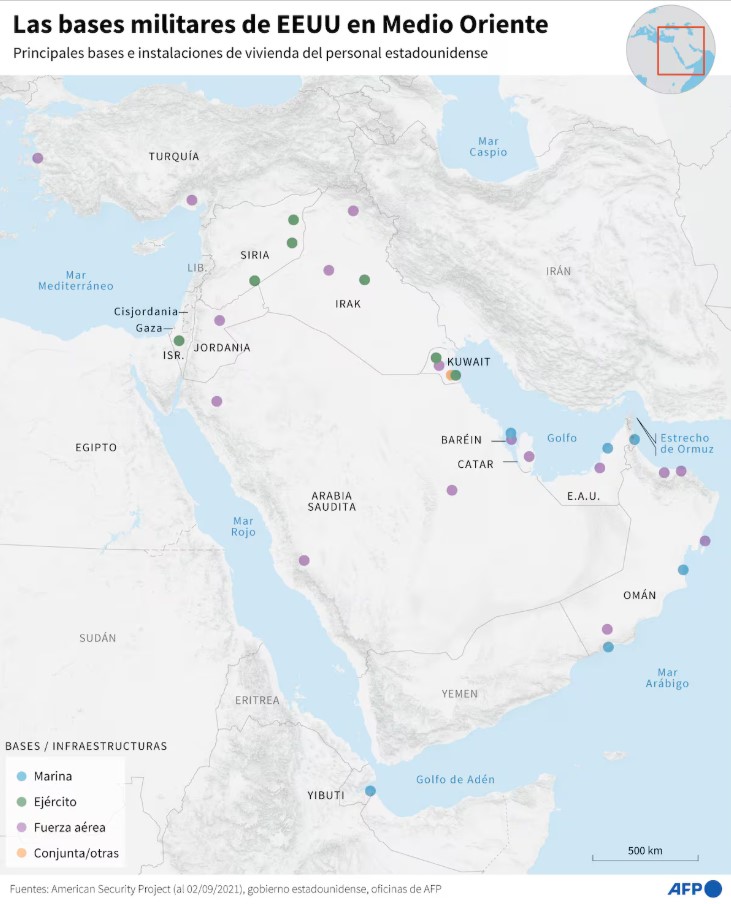
US military bases in the Middle East Photo: AFP
It is a major U.S. logistics hub in the Middle East, used as a maintenance base for armored vehicles and helicopters, and as a key transit point for troops entering or leaving the region.
It covers approximately 40 square kilometers and houses between 9,000 and 10,000 people , including troops, contractors and foreign personnel.
Also in Kuwait is the Ali Al Salem Air Base, about 40 kilometers from the Iraqi border and known as "The Rock" for its isolated and rugged surroundings.
It is home to the 386th Air Expeditionary Wing, “the primary airlift hub and gateway for the deployment of combat power to joint and coalition forces in the region,” according to AFP.
There's also Camp Buehring, established during the 2003 Iraq War and a staging base for U.S. Army units deployed to Iraq and Syria. Its infrastructure can accommodate up to 14,000 soldiers.
Saudi Arabia The United States operates Prince Sultan Air Base, supporting U.S. military air defense assets, including Patriot missile batteries and Terminal High Altitude Area Defense (THAAD) systems.
It has two landing strips, each 4,000 meters long, capable of handling heavy aircraft.
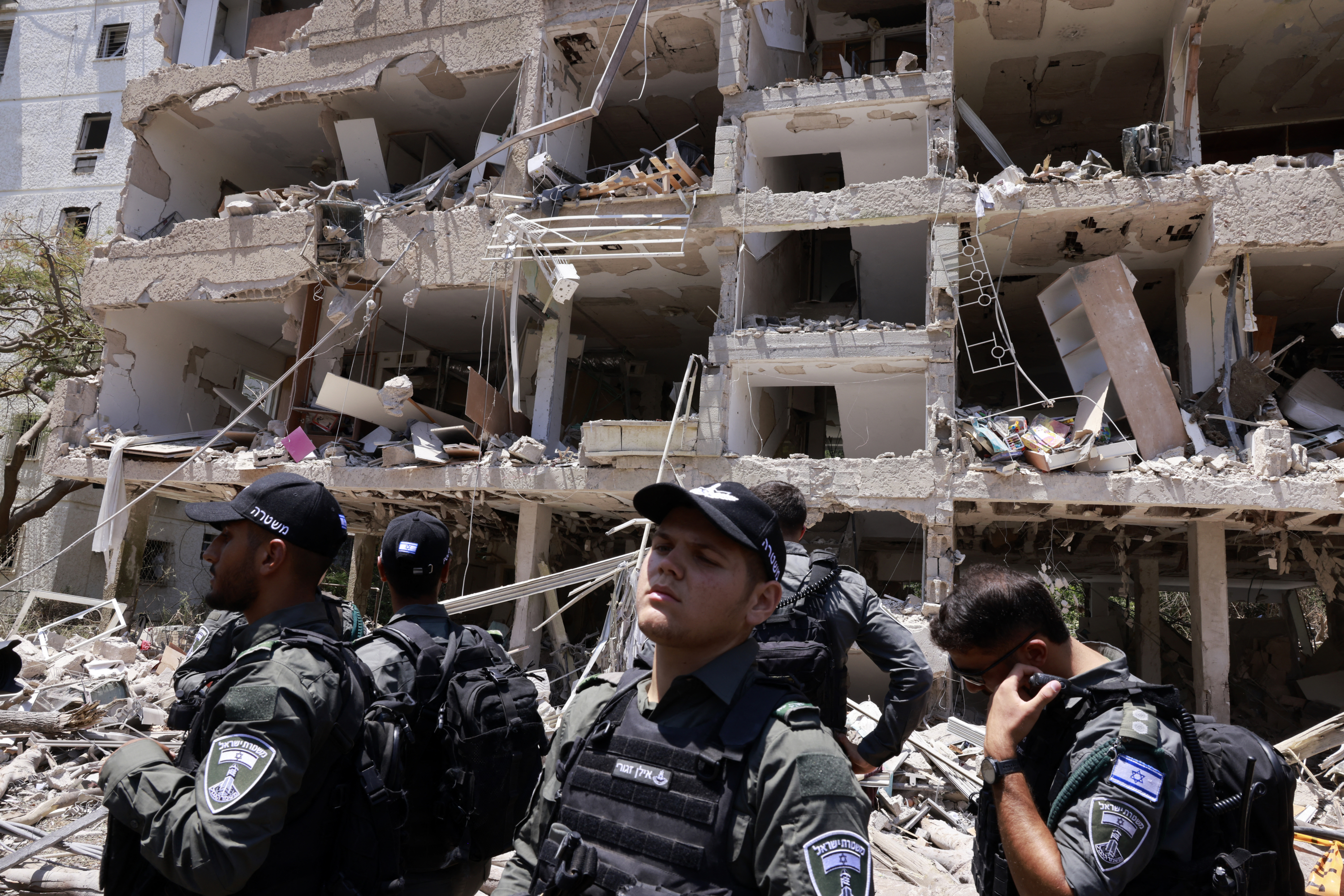
Israel Photo: AFP
The United States operates Al Dhafra Air Base, home to the 380th Air Expeditionary Wing, a force of 10 squadrons of MQ-9 Reaper drones.
It has two parallel runways, each 3,661 meters long, capable of receiving everything from F-16 aircraft to large military transport aircraft.
Al Dhafra is also home to the Gulf Air Warfare Center for air and missile defense training.
On January 24, 2022, the base was attacked by Zulfiqar missiles launched by Yemen's Houthis, which were successfully intercepted by Patriot missiles.
Iraq The United States maintains a presence at Ain Al Asad Air Base in western Anbar province, where its troops are tasked with supporting Iraqi security forces and contributing to the NATO mission, according to the White House.
It has been a recurring target of Grad rockets and ballistic missiles by Iranian militias and Islamic State factions.
Another location is Erbil Air Base, located in the semi-autonomous Kurdistan region, which serves as a hub for U.S. and coalition forces conducting training exercises and combat maneuvers.
The United States once had 160,000 troops in Iraq at more than 500 bases during the invasion that toppled Saddam Hussein in 2003. The official withdrawal was completed in 2011, and currently about 2,500 U.S. troops remain in the country in advisory and training roles.
Syria The United States has tactical installations in Syria, not permanent bases. Its presence is primarily in the northeast, where it supports the Syrian Democratic Forces (SDF) against remnants of the Islamic State.
In April, the Pentagon announced it would reduce the number of its forces in the country by nearly half, which currently stands at about 2,000.
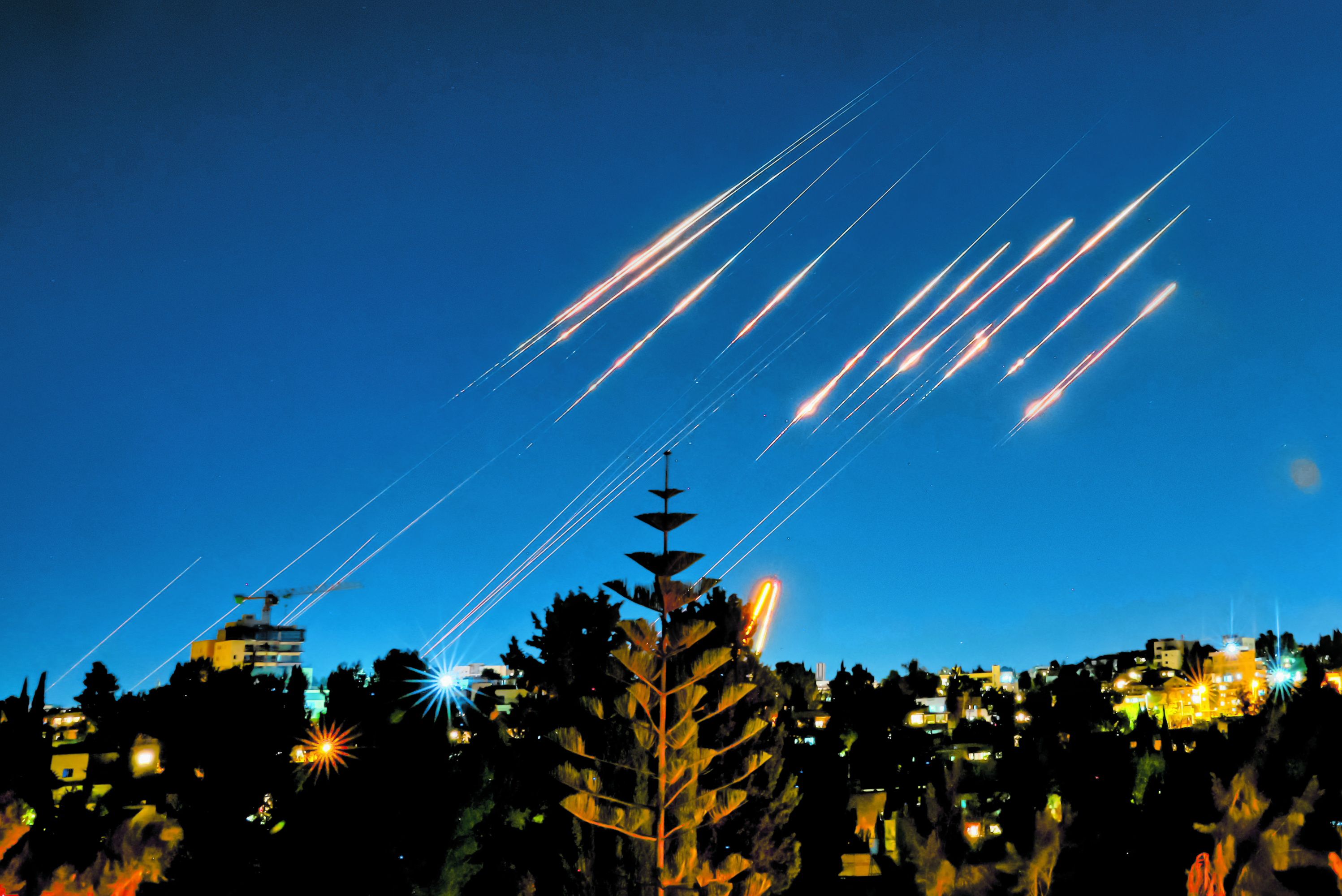
Iranian missiles seen from Jerusalem on June 14. Photo: Menahem Kahana. AFP.
In June, the United States also announced that it would reduce the number of temporary military bases it operates in the country from eight to one, and that it would change its policies toward Syria "because none have worked."
Jordan The United States operates Muwaffaq al-Salti Air Base, located in Azraq, 100 kilometers northeast of the capital, Amman. This base is home to the 332nd Air Expeditionary Wing of U.S. Air Forces Central, which participates in missions in areas where the Islamic State operates, particularly in Syria and Iraq.
It is a regular base for MQ‑9 Reaper drones and F‑15E and F‑16C fighters.
eltiempo





